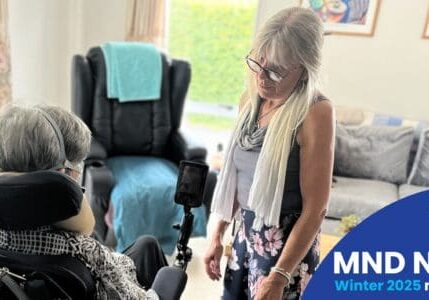Q&A with expert Peter Crouch on recent copper-ATSM trial results
Research
17 January 2019

Promising research results announced this week from an Australian clinical trial using a compound called copper-ATSM show that the drug is safe and effective in the effort to defeat Motor Neurone Disease.
As this breakthrough in research has made headlines, we put together a Q&A with University of Melbourne neuroscientist Associate Professor Peter Crouch to help you get the most accurate information about the latest results and how this will affect the MND community. Promising research results announced this week from an Australian clinical trial using a compound called
copper-ATSM show that the drug is safe and effective in the effort to defeat Motor Neurone Disease.
It has taken the Melbourne-based research team 15 years of working with the compound to get to this stage of trialling the medication on 32 people living with MND. Phase 1 is now complete, and the drug has achieved a huge milestone in proving it is both safe and effective for the participants.
As this breakthrough in research has made headlines, we put together a Q&A with University of Melbourne neuroscientist Associate Professor Peter Crouch to help you get the most accurate information about the latest results and how this will affect the MND community.
What is copper-ATSM?
It is a compound comprised of copper and a special chemical scaffold that holds the copper in place. Significantly, when taken as an oral medication, the compound effectively reaches regions of the brain and spinal cord where it’s needed to combat MND.
What can copper-ATSM do for people with MND?
It is intended that the drug will slow, and hopefully reverse, the effects of MND.
It is not claiming to cure MND at this time. Extensive experiments conducted in research laboratories have proven copper-ATSM to be the most robust potential treatment for MND ever developed. It is hoped that these promising results from the laboratory translate into robust efficacy in the near future when copper-ATSM goes through the next round of clinical testing.
Is there a drug to cure MND on the market?
Not at this time. Additional clinical testing is still required before copper-ATSM can be prescribed to people with MND.
Are there any medications available to help people living with MND?
Yes, there is one available here in New Zealand. Riluzole, (Rilutek)
However it is said to help minimally with MND symptoms.
Other medications can be prescribed by a doctor to help with general muscle twitching and other symptoms related to MND and can be discussed with your support worker.
What are the most recent results of the trial in Australia?
32 participants in Australia were given copper-ATSM as an oral medication and results from the trial have confirmed that copper-ATSM is safe to take as a treatment for MND, with minimal side effects. This is a critical milestone to reach in the drug development process because it means important criteria have been met and that the drug can now move on to the second phase of clinical testing.
Some media reports have described a 70% improvement for patients taking copper-ATSM. But what does that mean? Peter says, “these are very exciting indications for copper-ATSM being an effective treatment for MND.” But he also cautions that the primary objective for any phase 1 trial is to identify a safe dose to administer to patients. Positive outcomes from the next phase of clinical testing are needed to confirm the drug’s therapeutic activity.
Where was the trial?
The trial was held in Sydney and Melbourne Australia and took two years to complete.
Who participated in the trial?
32 people with clinically confirmed MND and with a time from diagnosis of not more than two years, were chosen to participate in Phase 1 of the trial.
What is next for the Trial?
Phase 2 is intended to commence in the second half of 2019 and will involve approximately 80 MND patients. Full details of the phase 2 trial, including details of the participating countries and clinics, are yet to be confirmed. It is expected that the trial will be conducted in Melbourne and Sydney and it is not yet known if this will be extended to other cities or countries.
How long is Phase 2 of the trial going to take?
The next phase of testing is likely to take another two to three years to complete. The goal is that with a larger number of people trialling the drug, and with the inclusion of a placebo group in the study, copper-ATSM will prove to offer very good results in slowing down the degenerative process of MND.
After Phase 2 what’s next?
If outcomes from phase 2 testing are promising, copper-ATSM will move on to the even larger scale phases of testing that are required before the drug can formally be approved as a treatment for MND.
Can people take copper or other forms of natural metal compounds to assist in their management of MND symptoms?
It is important to know that it is the combination of copper with the ATSM chemical scaffold that is important in the therapeutic activity of copper-ATSM. Regular copper supplements available from health food stores are not the same as copper-ATSM and they are not expected to have the same therapeutic activity. It is best to seek advice from your support worker and physician.
How can I find out more information?
Further discussion of the phase 1 trial for copper-ATSM can be found here: https://mndresearch.blog/2019/01/15/whats-the-story-with-cuatsm/
Additionally, the website for the drug company running the copper-ATSM clinical trials is:
www.colmeddev.com


